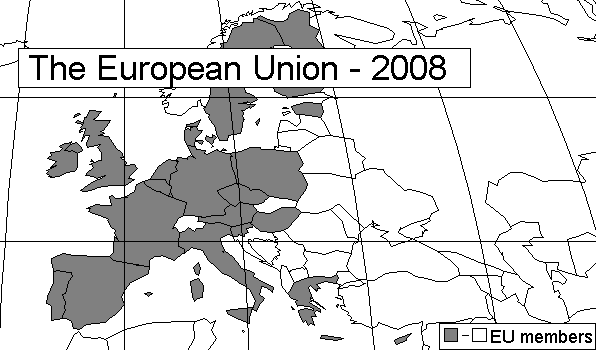
The instability of the transformation process
8) The instability of the transformation process
About two-third of the world’s people now live under relatively pluralistic and democratic regimes. Does history end there? Since 1980, nearly 85 elections were held in East and South-East Asia. In Sub-Saharan Africa (since 1990 30 multiparty elections), Latin America (since 1974 150 elections) and in the Arab world (since 1990 22 general elections) democracy - in the formal sense - seems to have strengthened. Thus, the democratic experience of Eastern Europe after 1989 seems to be a general trend. But is it all really so? The long-run tradition of a bourgeoisie national state is the differentia specifica between the centers and the peripheries (Amin, 1997). Nationalism will continue to receive a powerful impetus from the contradictions of globalization. One important more recent theory (Huntington) holds, that cultural dividing lines increasingly achieve relevance; and even could threaten to endanger the transformation project to build up a stable, market oriented western democracy on the ruins of communism.
To those, accustomed to the dialogue about international politics as a 'dismal science' it will be no surprise to learn about recent international research results regarding genocide and mass murder in this century (Rummel, 1994, 1995). 218 repressive regimes (141 state regimes and 77 quasi-state and group regimes) from 1900 to 1987 have killed nearly 170 million of their own citizens and foreigners - about four times the number of people killed in domestic and international wars during that same period. Among the mass murderous regimes of this century, totalitarian communism alone is accountable for more than 100 million deaths (Rummel, 1994, 1995). Power kills; democracy is the general method of non-violence, says Rummel: but what happens, if democracy and non-violence are seriously undermined by ethno-political conflict? After the horrors of the Holocaust and the Second World War, the following victimization of mostly civilians stand out in contemporary history:
Graph 8.1a: victims of mass murder

Legend: victims of totalitarian regimes since 1900. Source: our own compilations from Stiftung Entwicklung und Frieden, 1996, based on Rummel, 1994. The statistical tables, contained in Rummel’s website (http://www.freedomnest.com) about the victims of democide and repression in history are:
|
Chinese Infanticide 1971- |
110 |
|
Soviet Union |
61,9 |
|
All Wars,30BC-19AD |
40,5 |
|
Wars 1900- |
38 |
|
Communist China |
35,2 |
|
Old China (-1900) |
33,5 |
|
Mongols 1300 - 1400 |
29,9 |
|
Chinese Leap Forward |
27 |
|
Nazi Germany |
20,9 |
|
African Slavery |
17,3 |
|
American Indians |
13,8 |
|
Nationalist China |
10,1 |
|
Japan (1936-45) |
5,9 |
|
Old India (-1800) |
4,5 |
|
Chinese guerrilla (1923-49) |
3,5 |
|
other 20th Century murderers |
2,8 |
|
Old Iran (-19th Century) |
2 |
|
Ottoman Emp.(-19th Century) |
2 |
|
Pol Pot |
2 |
|
Turkey 1909-18 |
1,9 |
|
Communism in Vietnam 1945-87 |
1,7 |
|
North Korea |
1,7 |
|
Poland (1945-48) |
1,6 |
|
Old Japan (-19th Century) |
1,5 |
|
Pakistan (1958-87) |
1,5 |
|
Mexico (1900-20) |
1,4 |
|
Tito (1944-87) |
1,1 |
|
Old Russia (-19th Century) |
1 |
|
Crusades 1095-1272 |
1 |
|
Zarist Russia 1900-17 |
1 |
|
Aztecs |
1 |
|
Atatürk 1919-23 |
0,9 |
|
Chinese Warlords (1917-49) |
0,9 |
|
UK 1900-87 |
0,8 |
|
Portugal 1926-82 |
0,7 |
|
Indonesia 1965-87 |
0,7 |
|
Spanish Inquisition 1500-1700 |
0,35 |
|
French Revolution |
0,263 |
|
Albigensian Crusade (1208-1249) |
0,2 |
|
Witch Hunts (1400-1600) |
0,1 |
|
Grand Total (regimes and repressions 1-40) |
482,113 |
Rummel’s research on democide and war poses very intricate questions to the very nature, that we world system researchers see our role as social scientists:
"Political scientists almost everywhere have promoted the expansion of government power. They have functioned as the clergy of oppression" (Rummel, 1998: http://www.freedomnest.com)
In absolute terms, we get the following distribution of democide and other victims of politics in history:
|
(1) Marxism in the 7 most brutal comunist regimes of the world since 1917 (USSR, China, Vietnam, North Korea, Cambodia, Poland, Yugoslavia) |
135,7 |
|
(2) Chinese Infanticide 1971 onwards |
110 |
|
(3) Old Asia |
91,3 |
|
(4) all wars in history |
78,5 |
|
(5) the victims of the expansion of the capitalist world economy: Africans and Latin American Indians |
47,9 |
|
(6) National Socialism |
20,9 |
|
all others (482 million victims minus the victims of regimes 1-7) |
15 |
|
(7) 3rd world dictatorships-1900 onwards |
10,16 |
Legend: our own calculations from Rummel’s website
Graph 8.1b now shows the distribution of the victims of mass murder by regime and repression type:
Graph 8.1b: victims of mass murder
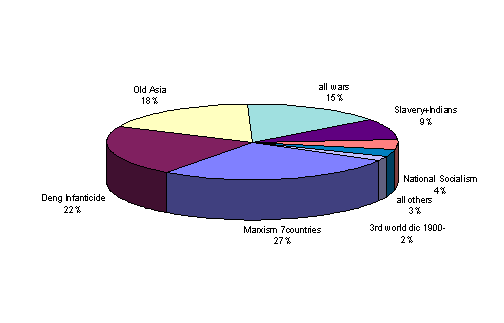
Legend: our own calculations from Rummel, see above
Who will be the groups that most violently are going to challenge the logic of accumulation on a global scale? Does capitalist globalization, that process of unequal and uneven development, in the end cause the cultural conflicts in the world system, as globalization theories would maintain (Axtmann, 1995)? Among the most murderous regimes of our waning 20th Century, which killed 169.2 million people from 1900 to 1987, only 2 belonged to the capitalist center - the UK as a retreating colonial power, and Germany (see below), which might be termed as a semi-semi-periphery, and not a proper center at the time of the onset of the National Socialist threat (Pommerania, Eastern Prussia), while 37 others were countries of the periphery and the semi-periphery. Peace and survival on earth will be determined to a great degree, whether or not democratic, and not authoritarian ‘reform’ models will take hold. Both German Nazism and Communism in the 7 leading most repressive Marxist regimes of the world since 1900, in between them share already 31% of estimated violent deaths in history, to which one should add the 22%, comprised by China’s infanticide (Rummel, 1998, website).
Ethno-nationalistic conflicts, terrorism and war were to break out along the real 'earthquake line' in today's international system, the great dividing line between the cultures. That is at least what Samuel Huntington, Harvard professor of political science and for many years one the closest advisers of successive United States governments on matters of international security and military policy, has maintained in his recent contributions. Our counter-thesis is that the cultural conflict lines might overlap more and more with the conflict lines between centers and peripheries,
Huntington tries to offer a socio-cultural explanation to the question, where Europe's frontier will be finally drawn. Are there clear empirically observable tendencies in development performance according to the classification, suggested by Huntington, of the basic underlying socio-cultural patterns of a given country, distinguishing the Orthodox and Islamic regions of the world economy as the least compatible with the logic of market-oriented development? The following graph shows the probable borders of the European Union by around 2008 - they do not exactly overlap, but well coincide with the Huntington map. The two remaining Baltic states, Slovakia, the present EU-member Greece and the future member Cyprus and the rest of former Yugoslavia could become the zones, where the spheres of influence between the Protestant and Catholic Western and Orthodox Eastern Europe will be most fiercely contested:
Map 8.1: The European Union - 2008

Legend: a successful EU extension scenario, based on the ‘5 + 1’ model, including the Czech Republic, Slovenia, Poland, Hungary, Estonia, and Cyprus (from West to East)
Professor Huntington's thesis is not at all abstract and has - however we view it - a vital importance for the future of the European Union. From Marseilles to Algiers, from Madrid to Rabat, from Rome to Tunis or Sofia, from Athens to Bucharest or Cairo, from Vienna to Kiev or Ankara or Teheran geographical distances are smaller or about equal as the distances from these European Union cities to the Canary Islands, the Irish Republic, northern Scotland or northern Scandinavia or other remoter parts of the already existing Union. The migration pressures from Eastern Europe and the population explosion on the southern rim of the Mediterranean will increase. In 30 years, the population balance on the southern rim of Europe will have dramatically shifted. The southern border of Europe already is and will even more so become a border between relatively wealthy developed societies and societies, that are threatened by overpopulation, scarcity of resources, and poverty. By the year 2000, 290 million people will live in the 19 countries of the Arab world alone. Today, less than three-fifths of the rural population have access to safe water, 80 million people are illiterate, 50 million of them females, 10 million people are underfed, 73 million Arabs live below the line of absolute poverty. Average life expectancy is still 61.9 years, 40 million people have no access to health services, while 50.4 thousand million $ were spent on armaments. Arms imports in the Arab world amounted to 3.5 thousand million $ in 1992 alone (our own compilation from UNDP, 1995). These tendencies are all the more notable, because eastward expansion of NATO and the EU is not synchronic, and the most probable outcome would leave open an entire geographical corridor from Russia and Belarus right through to Switzerland. While Ireland, Sweden, Finland, and Austria are the four neutral EU members, the Slovak Republic - left out - would provide a corridor through the European heartland - from Kiew to Geneva. The most realistic scenario is of course Huntington’s borderline between western Christianity (Catholics and Protestants) on the one hand and Orthodox Christianity and Islam on the other hand in Europe. Huntington’s European eastern border rather would look like the following:
Map 8.2: Huntington’s border of the EU, 2008
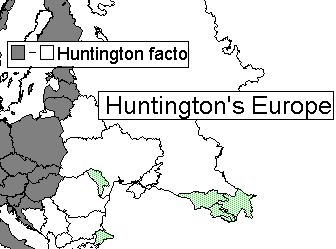
Legend: Huntington’s theory, applied to the eastern border of the European Union. Scandinavia, the Baltic States, Poland, the Czech and Slovak Republics, Hungary, Slovenia and Croatia are seen as part of the West; while the rest of Eastern Europe belongs to the Orthodox or Islamic heritage.
The still existing high concentration of development problems and population dynamics in the immediate vicinity of Europe over the next 30 years will dramatically change the shape of international politics, economics and migratory pressures in the region. Huntington’s theory of course can be challenged from the perspective of dependency theory. A dependency-oriented explanation of underdevelopment would hold, that the ‘Huntington factor’ is in reality disappearing, whenever we control for MNC penetration. Thus MNC penetration, and not ‘the Huntington factor’ are responsible for the semi-peripherization of the Islamic world in particular. The main result of our own investigation will be that the Huntington factor only plays a certain role when we do not control for the amount of MNC penetration; however, if we do consider MNC penetration properly, the effects become indeed weaker or are even the reverse.
The( in)validity of Huntington's culture conflict approach on a world level
However forceful Huntington’s theory might seem to be at first sight, we can consider it to be falsified by our investigations. While Lipset and Weede seem to be inclined to regard Confucianism as a growth precondition, Huntington's theory is more pessimistic and foresees a joint rising world cultural challenge against the dominant centers by Islam and Orthodoxy. The important element for the test of Huntington's theory seems to be the joint interaction of Islam and or Orthodoxy, classified under his index. The Huntington-Index might be thus the mere reflection of this underlying geographical and world economic peripherization, that jointly affects the Orthodox and the Islamic world. This joint peripherization would cast a large shadow on the prospects for market-economic reform in Russia, Romania, Bulgaria, and the 'Federal Republic of Yugoslavia'.
Enough of ideologies. Let the hard facts speak. The Huntington-index of the clash of civilizations (Huntington-Index countries = 1, other countries = 0), is used here as an important control variable in macro-sociological explanations of world development:
Table 8.1: the influence of Huntington's index on development performance at the level of world society
|
MNC PEN73 |
Govex |
Trade Dep |
social sec |
Huntington-I |
Women Parl |
Women %LF |
ln PCI |
ln PCI^2 |
ln(MPR+1) |
Fertility Rate |
Constant |
|
|
adjustment |
-0,761 |
-1,491 |
0,125 |
-3,538 |
0,048 |
-0,058 |
0,83 |
0,133 |
0,01 |
-0,024 |
-0,004 |
21,47 |
|
0,188 |
1,029 |
0,349 |
5,208 |
0,029 |
0,04 |
0,806 |
0,06 |
0,007 |
0,022 |
0,002 |
19,93 |
|
|
0,301 |
2,649 |
|||||||||||
|
4,341 |
111 |
|||||||||||
|
335,1 |
779,1 |
|||||||||||
|
t-Test |
-4,035 |
-1,449 |
0,359 |
-0,679 |
1,684 |
-1,46 |
1,03 |
2,193 |
1,353 |
-1,08 |
-1,989 |
|
|
MNC PEN73 |
Govex |
Trade Dep |
social sec |
Huntington-I |
Women Parl |
Women %LF |
social sec |
ln PCI^2 |
ln(MPR+1) |
Fertility Rate |
Constant |
|
|
growth |
-0,944 |
-0,625 |
0,167 |
-4,228 |
0,021 |
-0,084 |
0,209 |
0,138 |
0,015 |
-0,038 |
-0,003 |
26,73 |
|
0,165 |
0,9 |
0,305 |
4,558 |
0,025 |
0,035 |
0,706 |
0,053 |
0,007 |
0,02 |
0,002 |
17,45 |
|
|
0,409 |
2,319 |
|||||||||||
|
6,997 |
111 |
|||||||||||
|
413,8 |
596,8 |
|||||||||||
|
t-Test |
-5,723 |
-0,694 |
0,546 |
-0,928 |
0,844 |
-2,426 |
0,296 |
2,616 |
2,311 |
-1,956 |
-1,645 |
|
|
LEX 1960 |
1 der e-funct |
1 der p-func |
MNC PEN73 |
Viol Civ Rits |
Trade Dep |
Terms Trade |
Huntington-I |
Women Parl |
Women %LF |
ln(MPR+1) |
Constant |
|
|
DYN |
0,811 |
-0,025 |
-0,038 |
0,984 |
0,013 |
0,001 |
-0,049 |
2E-04 |
-0,706 |
-29,49 |
-0,299 |
26,79 |
|
LEX |
0,885 |
0,024 |
0,031 |
0,708 |
0,017 |
0,006 |
0,173 |
0,002 |
0,742 |
6,961 |
0,037 |
2,724 |
|
0,737 |
2,257 |
|||||||||||
|
28,23 |
111 |
|||||||||||
|
1582 |
565,3 |
|||||||||||
|
t-Test |
0,916 |
-1,054 |
-1,216 |
1,391 |
0,793 |
0,238 |
-0,282 |
0,147 |
-0,952 |
-4,237 |
-7,993 |
|
|
pol rights |
MNC PEN73 |
Govex |
Trade Dep |
social sec |
Huntington-I |
Women Parl |
Women %LF |
ln PCI |
ln PCI^2 |
ln(MPR+1) |
Fertility Rate |
Constant |
|
violations |
0,536 |
1,045 |
0,079 |
-1,473 |
0,02 |
0,06 |
1,002 |
-0,103 |
0,004 |
0,009 |
5E-04 |
5,987 |
|
0,108 |
0,588 |
0,199 |
2,976 |
0,016 |
0,023 |
0,461 |
0,035 |
0,004 |
0,013 |
0,001 |
11,39 |
|
|
0,576 |
1,514 |
|||||||||||
|
13,68 |
111 |
|||||||||||
|
344,9 |
254,4 |
|||||||||||
|
t-Test |
4,973 |
1,778 |
0,399 |
-0,495 |
1,193 |
2,663 |
2,175 |
-2,992 |
0,939 |
0,713 |
0,453 |
|
|
MNC PEN73 |
Govex |
Trade Dep |
social sec |
Huntington-I |
Women Parl |
Women %LF |
ln PCI |
ln PCI^2 |
ln(MPR+1) |
Fertility Rate |
Constant |
|
|
civil rights |
0,354 |
1,21 |
-0,015 |
-0,074 |
0,002 |
0,037 |
0,571 |
-0,087 |
8E-04 |
-0,011 |
-9E-04 |
3,205 |
|
violations |
0,086 |
0,468 |
0,159 |
2,372 |
0,013 |
0,018 |
0,367 |
0,028 |
0,003 |
0,01 |
8E-04 |
9,077 |
|
0,586 |
1,206 |
|||||||||||
|
14,28 |
111 |
|||||||||||
|
228,7 |
161,5 |
|||||||||||
|
4,121 |
2,582 |
-0,093 |
-0,031 |
0,177 |
2,027 |
1,554 |
-3,15 |
0,244 |
-1,115 |
-1,041 |
||
|
HDI |
MNC PEN73 |
Govex |
Trade Dep |
social sec |
Huntington-I |
Women Parl |
Women %LF |
ln PCI |
ln PCI^2 |
ln(MPR+1) |
Fertility Rate |
Constant |
|
-0,095 |
0,173 |
0,006 |
0,02 |
-5E-04 |
-0,003 |
-0,033 |
7E-04 |
-2E-04 |
7E-04 |
6E-05 |
0,488 |
|
|
0,008 |
0,043 |
0,015 |
0,217 |
0,001 |
0,002 |
0,034 |
0,003 |
3E-04 |
9E-04 |
8E-05 |
0,832 |
|
|
0,871 |
0,111 |
|||||||||||
|
67,9 |
111 |
|||||||||||
|
9,137 |
1,358 |
|||||||||||
|
-12,04 |
4,018 |
0,392 |
0,092 |
-0,38 |
-1,72 |
-0,986 |
0,26 |
-0,598 |
0,736 |
0,808 |
||
|
MNC PEN73 |
Govex |
Trade Dep |
social sec |
Huntington-I |
Women Parl |
Women %LF |
ln PCI |
ln PCI^2 |
ln(MPR+1) |
Fertility Rate |
Constant |
|
|
-0,071 |
0,101 |
-0,006 |
0,16 |
6E-04 |
-0,002 |
-0,032 |
0,002 |
-1E-04 |
4E-04 |
8E-05 |
0,026 |
|
|
0,006 |
0,031 |
0,011 |
0,159 |
9E-04 |
0,001 |
0,025 |
0,002 |
2E-04 |
7E-04 |
6E-05 |
0,608 |
|
|
0,873 |
0,081 |
|||||||||||
|
69,29 |
111 |
|||||||||||
|
4,971 |
0,724 |
|||||||||||
|
Gender Development Index |
||||||||||||
|
-12,38 |
3,232 |
-0,609 |
1,008 |
0,692 |
-2,021 |
-1,311 |
1,096 |
-0,58 |
0,568 |
1,401 |
||
|
MNC PEN73 |
Govex |
Trade Dep |
social sec |
Huntington-I |
Women Parl |
Women %LF |
ln PCI |
ln PCI^2 |
ln(MPR+1) |
Fertility Rate |
Constant |
|
|
-0,02 |
0,016 |
0,015 |
-0,184 |
0,001 |
0,005 |
-0,018 |
0,003 |
-2E-04 |
-6E-05 |
4E-05 |
0,866 |
|
|
0,004 |
0,023 |
0,008 |
0,114 |
6E-04 |
9E-04 |
0,018 |
0,001 |
2E-04 |
5E-04 |
4E-05 |
0,437 |
|
|
0,818 |
0,058 |
|||||||||||
|
45,46 |
111 |
|||||||||||
|
1,691 |
0,375 |
|||||||||||
|
Gender Empowerment Index |
||||||||||||
|
MNC PEN73 |
Govex |
Trade Dep |
social sec |
Huntington-I |
Women Parl |
Women %LF |
ln PCI |
ln PCI^2 |
ln(MPR+1) |
Fertility Rate |
||
|
-4,882 |
0,7 |
2,019 |
-1,606 |
1,868 |
6,039 |
-1,006 |
1,946 |
-0,958 |
-0,117 |
1,015 |
||
|
MNC PEN73 |
Govex |
Trade Dep |
social sec |
Huntington-I |
Women Parl |
Women %LF |
ln PCI |
ln PCI^2 |
ln(MPR+1) |
Fertility Rate |
%agland |
Constant |
|
|
%forest |
-0,391 |
-1,834 |
-5,294 |
-2,078 |
28,24 |
0,334 |
0,689 |
-10,99 |
-0,366 |
-0,082 |
0,107 |
0,008 |
-63,58 |
|
area |
0,128 |
1,408 |
7,606 |
2,559 |
38,26 |
0,211 |
0,293 |
5,918 |
0,46 |
0,055 |
0,164 |
0,014 |
146,8 |
|
0,313 |
19,45 |
||||||||||||
|
4,173 |
110 |
||||||||||||
|
18940 |
41610 |
||||||||||||
|
t-Test |
-3,043 |
-1,303 |
-0,696 |
-0,812 |
0,738 |
1,584 |
2,353 |
-1,856 |
-0,797 |
-1,495 |
0,654 |
0,564 |
|
|
MNC PEN73 |
Govex |
Trade Dep |
social sec |
Huntington-I |
Women Parl |
Women %LF |
ln PCI |
ln PCI^2 |
ln(MPR+1) |
Fertility Rate |
%agland |
Constant |
|
|
annual |
0,015 |
0,091 |
-0,646 |
-0,22 |
3,273 |
0,008 |
0,001 |
0,278 |
-0,054 |
0,003 |
-0,004 |
3E-04 |
-11,53 |
|
deforest |
0,006 |
0,07 |
0,377 |
0,127 |
1,898 |
0,01 |
0,015 |
0,294 |
0,023 |
0,003 |
0,008 |
7E-04 |
7,281 |
|
0,336 |
0,965 |
||||||||||||
|
4,643 |
110 |
||||||||||||
|
51,87 |
102,4 |
||||||||||||
|
t-Test |
2,324 |
1,306 |
-1,712 |
-1,732 |
1,724 |
0,748 |
0,099 |
0,946 |
-2,367 |
1,181 |
-0,511 |
0,511 |
|
|
MNC PEN73 |
Govex |
Trade Dep |
social sec |
Huntington-I |
Women Parl |
Women %LF |
ln PCI |
ln PCI^2 |
ln(MPR+1) |
Fertility Rate |
%agland |
Constant |
|
|
ethno |
0,009 |
0,098 |
0,218 |
-0,059 |
0,91 |
0,016 |
0,032 |
0,511 |
-0,032 |
-0,002 |
-0,02 |
-0,001 |
-3,323 |
|
warfare |
0,011 |
0,118 |
0,638 |
0,215 |
3,207 |
0,018 |
0,025 |
0,496 |
0,039 |
0,005 |
0,014 |
0,001 |
12,3 |
|
0,109 |
1,63 |
||||||||||||
|
1,116 |
110 |
||||||||||||
|
35,59 |
292,4 |
||||||||||||
|
t-Test |
0,816 |
0,83 |
0,342 |
-0,275 |
0,284 |
0,884 |
1,292 |
1,031 |
-0,823 |
-0,391 |
-1,444 |
-0,985 |
|
|
MNC PEN73 |
Govex |
Trade Dep |
social sec |
Huntington-I |
Women Parl |
Women %LF |
ln PCI |
ln PCI^2 |
ln(MPR+1) |
Fertility Rate |
%agland |
Constant |
|
|
destab./ |
0,002 |
0,029 |
0,073 |
-0,033 |
0,535 |
-6E-04 |
-0,002 |
-0,048 |
-0,008 |
-0,001 |
-2E-04 |
-4E-04 |
-1,938 |
|
war |
0,003 |
0,028 |
0,153 |
0,052 |
0,771 |
0,004 |
0,006 |
0,119 |
0,009 |
0,001 |
0,003 |
3E-04 |
2,959 |
|
0,095 |
0,392 |
||||||||||||
|
0,965 |
110 |
||||||||||||
|
1,78 |
16,92 |
||||||||||||
|
t-Test |
0,885 |
1,02 |
0,477 |
-0,633 |
0,693 |
-0,151 |
-0,28 |
-0,399 |
-0,883 |
-1,078 |
-0,049 |
-1,55 |
|
Legend: our own calculations with EXCEL 4.0 and 5.0. As in all EXCEL 5.0 outprints in this work, first row: unstandardized regression coefficients, second row: standard errors, last row: t-Test. The values immediately below the standard errors are R^2 (third row, left side entry), F, and degrees of freedom (fourth row).
The Huntington Index, under control for MNC penetration, is even significantly and positively related to adjustment and gender empowerment; and the only negative significant effect is the influence on deforestation. Traditional forms of globalization are responsible for the process of stagnation in the world periphery and semi-periphery. So, our empirical investigation can be regarded as supporting the concerns of the environmentalists in the Orthodox and the Islam world, but not as a support to Huntington’s theory. And this is quite another matter.
The return of dictatorship? Towards understanding the process of ethno-political conflict and the world-wide refugee problem
In 1989 we heard the prophecy of the 'end of history'. Instead of talking about the end of history, we might be faced with the acceleration of history. Deadly ethno-political conflicts continue to beset the world. In the international system, wars are of course not new; 16 of all the 21 wars with more than a million deaths in history happened during the 20th Century. From 1945 to 1992 more than 25 million people died in wars or as a direct consequence of wars (Stiftung Entwicklung und Frieden, 1997). Civilians have to pay an ever larger price for these wars; the tendency has been rising steadily and in 1990, already 90% of all war victims were civilians. The number of international refugees according to the most narrow definitions increased world-wide from 7.8 million in 1982 to 13.2 million according to the strictest criteria in 1996. To these numbers, one would have to add 3.4 million refugee-like situations of people in foreign countries and 23.5 million internal refugees. All together, there were at least 43 million refugees classified according to various categories around the world in 1991 (op. cit.: 184-185). But estimates of the real number of refugees reach as high as 500 million on a global scale (Datta, 1993).
Ethno-political conflicts are among the most vicious forms of international and domestic conflicts. Over 40% of the states of the world have more than 5 major ethnic groups within their borders, with at least one of them facing permanent discrimination (UNDP, 1994). There were 10 major ethnic conflicts in Europe, 6 in the Middle East, 28 in Asia, 23 in Africa, 3 in Latin America during the period 1993-94 (Gurr, 1994). These 50 lethal conflicts produced almost 4 million deaths and displaced 26.8 million people as refugees (Gurr, 1994: 351). It would be wrong, though, to assume that there are necessarily centrifugal tendencies in the international system as such that will still further extend these types of conflicts like bush-fires. Rather, Gurr in his far-reaching empirical work proposes to start from the hypothesis, that the collapse of the communist bloc is only partly to blame for the increase in ethno-political violence, since 54% of all ethno-political conflicts were started before 1987. Since the 1990s, already existing conflicts have tended to intensify, but the spreading of conflicts, Gurr argues, could be avoided. Contention for power, struggle for indigenous rights and ethno-nationalism were the main causes of these conflicts. Huntington's recent thesis about the clash of civilizations receives a considerable qualification from Gurr's empirical work: only 4 of the ethno-political conflicts correspond to the traditional left-right ideological struggle; while 18 are motivated by civilisational struggles (Gurr, 1994: 357). Although ethno-political conflict intensified after the end of the Soviet Union, it would be wrong to blame the first process on the second. The disintegration of the Soviet Union only increased an already existing tendency in world society. Power shifts, the emergence of new states, and revolutions still play an important role in the determination of conflict. But, according to Gurr, it would be wrong to assume, that the fragmentation tendency of the world system were to continue indefinitely. Rather, the most likely scenario will be an increase in communal contention about access to power in the weak and heterogeneous states in Africa. Secessionist conflicts outside Africa and the former communist bloc even declined in intensity over recent years (Gurr, 1994: 364). Map 8.3 shows the Gurr-Index on a world scale:
Map 8.3: ethno-political conflict in the world system
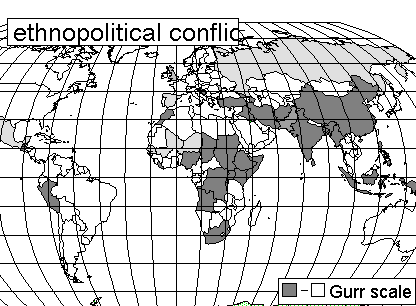
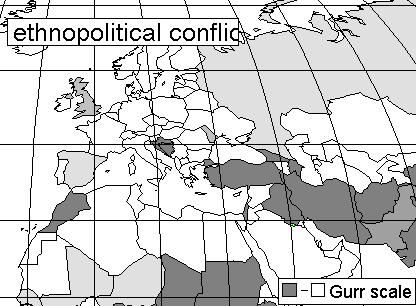
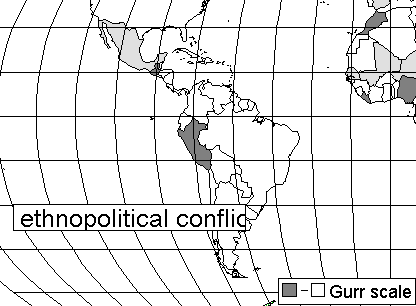
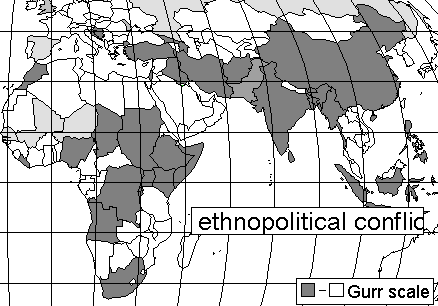
Legend: Gurr (1994) and EXCEL 7.0 map program, as applied to Gurr’s original data (Gurr, 1994: 369-375. The Gurr scale - magnitude of ethno-political conflict - is the squared root of the sum of deaths (in 10s of thousands) plus refugees (in 100s of thousands) from ethno-political conflicts 1993-1994. The darker, the more severe the ethno-political conflict.
Macroquantitative evidence on these processes is very difficult to construct and collect, as long as data collection and data reporting is so deficient in many of the new states of the East and continues to be so in the South as well. Thus, our model can be called only a preliminary test of the Deutsch/Huntington approach to ethno-political conflict and had to start with a few available data series that render themselves at least partially to the testing of the general patterns of the new realities of ethno-political conflict around the world. Our predictors included indicators of dependency (aggregate net transfers, that is to say, inflows that are greater than outflows due to international exploitation), of the liberal approach to development (political and human rights violations versus respect), and of the social-policy approach (mean years of schooling, adult literacy rate, human development index, the fertility rate and its change as an indicator of the process of demographic change). The Deutsch/Huntington school however regards alphabetization as an indicator of social mobilization, and hence as a threat to stability.
Our following analysis shows, that the threat to democracy in the semi-periphery and the periphery continues. Superficially, it seems to be, that similar conditions at different times produce similar theories and empirical results: during the emergence of the many new states in the 'Third World' in the early 1960s, more pessimistic versions of modernization theory gained ground. With the contemporary problems of democracy in the former 'Second World', the stability question of the new recently emerged or liberated states cannot be separated from such modernization theory dimensions anymore. In the model, that we propose, the chain of causation, underlying the empirical trends, is related to, but not completely patterned according to modernization theories. For Huntington, instability always was determined by social mobilization (SM), which works in the direction of instability (IST). This is at least the consistent interpretation, that Weede (1985) has proposed, and which we follow here.
Deutsch was even more radical than Huntington in expressing the idea that development is a threat to stability. His clearly formulated mathematical formula for political stability expects a positive trade-off between government sector size, income concentration and stability on the one hand and a negative trade-off between social mobilization, level of development and stability on the other hand (Deutsch, 1960/66). Let L denote alphabetization, pol the rate of participation of people in politics, which in developed societies could be substituted by v, voter participation; in many societies also by ve, the percentage of people, entitled to vote; let y10 denote the share of the richest 10% in total incomes, y the per capita income, and g, the state sector. St, stability, is then equal to
(8.1) St, = (g / L * pol) * (y10 / y)
The tragedy in former Yugoslavia could be regarded in many ways as a paradigmatic case, to be explained at least in part by Deutsch's theory. The Deutsch/Huntington school would believe that, however legitimate the issue of transformation from the communist political and economic system in that country might have been, the strategy to cling to communist regional power while opening up the country to the world market was the real and final reason for the break-out of the conflict. And seen in such a respect, this has important lessons for the rest of the region as well.
In fact, Yugoslavia in the 1980s held many world or at least European records in economic and social policy, that seem to be forgotten more and more in the futile debate about early international recognition of Slovenia, Croatia and Bosnia as the alleged main cause for the subsequent tragedy. At first inspection, Yugoslavia should have become a real miracle of neo-liberal economic transformation in the 1980s after the ethno-heterogeneous state class model of the 1970s came to a grinding halt. Malicious social scientists might dig out some day these old journal and book contributions, praising the old leadership for what it had achieved in the name of the market, the international financial institutions, and in the name of economic theory. Amen. We refrain from that: errare humanum est. Yugoslavia attempted the most-far-reaching neo-liberal transformation strategy in the region; and for that reason alone its experience should be carefully studied elsewhere: (i) Yugoslavia had the most rapid urbanization rate of all European countries from 1960 to 1990 (3.2% per annum). In fact, urban population doubled from 28% to 56% in just thirty years. This enormous potential and challenge of social mobilization was coupled with (ii) a very rapid process of economic transformation and a disappearance of the central state. Yugoslavia recorded the highest rate of gross domestic investment of all countries of the world with complete World Bank WDR data for 1988 and also the highest gross domestic savings rate for the same year. With a savings rate of 2/5 of the national income, Yugoslavia should have been well underway towards self-sustained growth. At the same time, however, the central government in Belgrade reduced in accordance with many international advisors and in a very radical fashion (iii) its role in national economic affairs to almost non-existence. Yugoslavia again holds a world record here, this time for having trimmed down the size of the national total government expenditure as percentage of GNP from 1972 - from 21.1% to 7.5% in 1988. It was the most radical economic transformation from socialism to dependent regional nationalism ever to have been recorded throughout the period of the end of communism in the world; because in no former communist country had there been such a deliberate attempt to reduce the share of the federal government below the 10%-mark. Leszek Balcerowicz also wants to reduce the state sector to 10%. Not even in Pinochet's Chile such a radical cure has been attempted.
In both relative and in absolute terms, Yugoslavia was a megaperformer of a kind of regional post-communist IMF-adapted adjustment. The price of the strategy was very clear, but many will shrug their shoulders and ask: so what? The price of the medicine is well-known from many countries now and in a way was also paid in most of the other countries of the region: absolute poverty - according to World Bank World Development Report figures 1990 - increased in the crucial years between 1978 and 1987 from 17% of the population to 25% of the population, and earnings per employee fell by 1.4% annually from 1980 to 1987. Still, household income distribution (iv) was still relatively egalitarian, with the highest 20% controlling just 42.8% of total incomes, and thus not tying the rich closely enough to their political system, so that they would be prepared to fight and die for it, while at the same time impoverishing the poor in absolute terms. All the necessary preconditions for instability, as predicted by Karl Deutsch more than 30 years ago, were present: and to complete the checklist for an absolutely assured crash in the light of Deutsch's nation-building theory, the country had recorded a fairly rapid economic growth rate in the period preceding the stagnation and disaster course of the 1980s; GDP growth stood at 6.0% in the period between 1965 and 1980 and was again in fact the highest economic growth rate in Europe.
The present study on the basis of a sample of 99 countries with complete data on transfers and ethno-political violence includes countries of the periphery and the semi-periphery, and nearly all newly-formed states of the former world of communism. There, the Gurr-Index of ethno-political conflict (EP) is significantly pushed upwards on the one hand by the degree of development of the productive forces. Lamentably enough, adjusted per capita income (PCI) increases, and not decreases ethno-political conflict in world society. This result confirms Deutsch's approach and rejects the still more optimistic vision of the trade-off between stability and development level, expressed by Huntington. The dialectic of the situation is further complicated by the fact, that countries, in order to avoid the stability trap of ethno-political conflict, have to undergo an early demographic and/or social and cultural transition; without that, the tendency towards ethno-political conflict even more increases. High fertility is related to subsequent high income concentration, low fertility to subsequent low income concentration (Tausch and Prager, 1993). With high fertility rates (FR) - or plausibly, a poorly developed mass communication system -, no reductions in the level of ethno-political conflict can be achieved. Deutsch furthermore believed, that especially in a crisis government sector size increases stability. Huge per capita aggregate net transfers, that is to say, inflows that are greater than outflows, decrease the level of ethno-political strife; while repressive states (REPRESS) are less prone to ethno-political conflict than full scale democracies. Thus stability-oriented 'Keynesianism' in the periphery is today being substituted by the 'Tiananmen formula': repression + capital inflows. There are some elements, that further qualify Deutsch's theory further: social mobilization (alphabetization) has no visible effect on instability:
Table 8.2: The determination of the Gurr-Index of ethno-political conflict in the periphery and semi-periphery
|
unstandardized regression |
t-value |
significant |
|
|
coefficient |
at 5%-level |
||
|
transfers per capita |
-0.74 |
-2.06 |
yes |
|
political rights violations |
-0.60 |
-2.65 |
yes |
|
human development index |
-0.51 |
-0.64 |
no |
|
repressiveness of the security |
|||
|
apparatus |
+6.22 |
+0.59 |
no |
|
population density^0.50 |
+0.04 |
+0.02 |
no |
|
adult literacy rate |
-0.03 |
-0.87 |
no |
|
mean years of schooling |
+0.02 |
+0.16 |
no |
|
ln PCI |
+0.91 |
+3.65 |
yes |
|
ln PCI^2 |
2.56 |
+0.25 |
no |
|
historical fertility rate |
+0.34 |
+2.76 |
yes |
|
failure of demographic |
|||
|
transition |
-0.00 |
-1.26 |
no |
________________________________________________________________
Legend: regression coefficients, T-test and significance. The sample was based on n = 99 countries with complete data; R^2 = 32.5%; F = 3.81; 87 degrees of freedom. 5% of ethno-political strife is being determined by our model. Net transfers mean, that inflows are greater than outflows due to international exploitation.
We should go back here once more to our Yugoslav example. Yugoslavia, by all its strenuous efforts to achieve a capitalist transformation, produced little in terms of real foreign capital inflows. Net private direct investments were 0 for the year 1988; while it relied - like Jordan and Egypt - to a heavy degree on the earnings of its labor force abroad. Although fertility rates were reasonably low by overall standards in the 1980s, Yugoslavia still was a relatively traditional society especially in terms of media exposure, thus still weakening the link between 'modernity' and the 'state' on the hand and 'the village' and later on the urban misery on the other hand, precisely at a time, when mass communication would have been necessary to hold society together. Again, Karl Wolfgang Deutsch predicted how important mass communication can become for stabilization, and how dangerous it is to neglect it. There were only 197 TV-sets per 1000 people in 1988-89; and only a daily newspaper circulation rate of 100 per 1000 people was achieved at the end of the old Yugoslavia in 1988-89. Thus, only Albania had a lower television density in Europe; and only Spain and Portugal had a worse newspaper circulation on the European continent. Combined, Yugoslavia had the worst media density in Europe. And do not forget, that the combined indices still hide the regional diversities between, say, rich Slovenia and the rural regions of Bosnia. Thus, traditional forms of communication were much stronger than the mass media, controlled by the party and the state, at a time, when great economic hardships hit the population and the state abandoned its role on the economic stage, thus unable to function politically in the end.
The frightening scenario emerging from this analysis is, that indeed a 'Yugoslavia' could re-appear at least under the following conditions in ethnically heterogeneous former communist countries
(i) a rapid urbanization process preceding transformation
(ii) coupled with great efforts to redirect economic resources towards economic growth
(iii) under the condition of a neo-liberal program to abolish large part of the former state economic influence on the economy
(iv) with little real resource flows coming in from the capitalist centers
(v) while at the same time, democracy only partially having been restored and
(vi) modern patterns of social behavior and/or mass communication, typical for a Western developed democracy, not yet fully developed
To make perhaps matters worse still, Yugoslavia, by not being a member of the European Union, could not send entire families of guest workers abroad for residence; and hundreds of thousands of youngsters - including the fighting generations of the war of the 1990s - were raised by the grandparents instead, who still kept alive the memories of the atrocities of the Second World War and the immediate post-war-periods, both characterized by repression and mass-murder. Yugoslavia again holds a European record - it was the European society with the highest worker remittances from abroad. The postwar guest-worker generation, which in many ways communicated much better with fellow Yugoslav nationalities than the parent generation, left the children behind to be raised in poor and backward villages, saving for all these private beautiful new homes. During the long winter nights, the tales of terror and atrocities, that characterize Yugoslav 20th Century history, were most probably rekindled by the grandparents in the minds and hearts of the young generation. Did one ever notice, that precisely the ‘adversaries’’ new houses were later so viciously being bombarded and burnt systematically to ruins during the long war of Yugoslav disintegration? The children, raised by their grandparents, in reality must have missed their far-away parents tremendously, and the children most probably began to hate their absent parents for having them deserted. 'Our son always wept so terribly when we departed after the holidays', an unnamed Yugoslav mother told us once, standing here for hundreds of thousands of Yugoslav parents. But you hardly will hate your own parents, rather, you will project the hatred against ‘the’ others - 'them', the 'opponents', the Albanians, the Bosnian Muslim, the Croats, the Serbs (named alphabetically), et cetera, who stand in the way to fully grasp the fruits of modernization. The preconditions for the disaster were thus already present; to make matters worse, the reforms of the regime came too late and never stopped short of steering a middle-course between guided democracy and repression. Thus, condition (vii) for the repetition of the Yugoslav tragedy anywhere else in the region could be a future migration regime of the European Union, that continues to separate migrants from their families and leaves children alone abroad.
Country risk analysis
This is the answer to the first question of 'country risk' analysis, the causes of instability. The lack of an early demographic transition (FAILURE DEM) and the degree of development (LN PCI) increase, while political rights violations and capital transfers significantly decrease the Gurr-Index of ethno-political conflict on a global level. Other indicators of social or political mobilization however fail to support other aspects of either Huntington's or Deutsch's theory. It should be noted, that there are insignificant predictors whose direction of influence cannot be explained by the conservative aspects of the Deutsch/Huntington tradition: the human development index and adult literacy rate, ceteris paribus, even decrease the level of ethno-political conflict, while mean years of schooling slightly increase the level of ethno-political conflict. The velocity of change in fertility rates also has no significant influence on the Gurr index.
In order to stabilize the newly-formed countries of the semi-periphery and the periphery, whose instability increases with the level of development, and which initially makes, say, Laos less prone to conflicts as Russia or the Ukraine, the following significant processes intervene:
* the real transfers from the centers of the world-wide market economy
* the continuing or newly formed power monopoly of a dictatorial group
* an early demographic transition
China received 11 thousand million $ of net foreign direct investment in 1992 alone. In relation to the practically predetermined fertility rate and the size of the per-capita-income, a government seems to be able to respond to the threats of ethno-political conflict by only two processes nowadays: by trying to attract foreign capital inflows and by preventing a further political democratization. In one word, the 'Tiananmen strategy'.
Aggregate net transfers, that is to say, inflows that are greater than the outflows due to international exploitation, are lowest in countries with civil rights violations very much in excess of political rights violations and in countries with a high human development index; a relatively repressive state machinery in an environment of already begun political reforms and a high human development index are conducive to low inflows or even real outflows of capital.
The trap for the countries of Orthodox Eastern Europe and the former USSR could not be worse in this context: they are low priority areas for transnational capital. Political reform has begun decisively even in countries, where civil rights violations are much higher than political rights violations, and because human development and thus also social expectations to the investor are higher than in the communist rest of Asia and in other (non-communist) dictatorships. Nothing, what has been written by political scientists in the 1960s, 1970s and 1980s has to be revoked in this context: semi-repressive regimes are more prone to instability and stagnation than full democracies and full dictatorships; and international capital flows react accordingly.
It seems worthwhile to reflect a while on the historical lessons of pre-war Europe for today’s transformation strategies. Quantitative evidence about the Great Depression already suggests the fatal connection between the economic slump of the 1930s and the totalitarian Right’s rise to power:
Graph 8.2: the Kondratieff cycle and instability in the Weimar Republic of pre-war Germany: the long economic swing and the Nazi vote
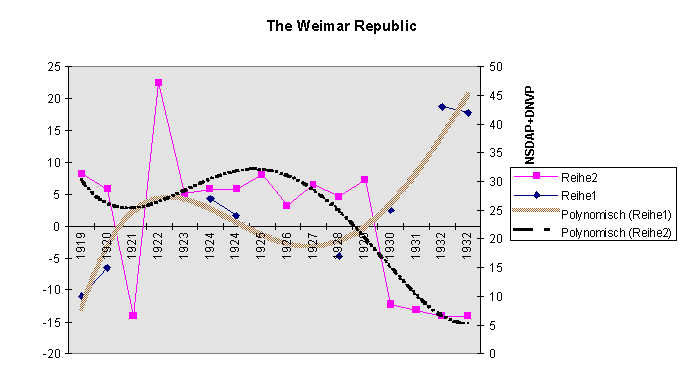
Legend: NSDAP + DNVP votes in Weimar general elections in % of the total vote (shady trend line; right-hand scale); economic growth or recession in the entire capitalist world system (left-hand scale, dotted trend line). Sources: Stephens, 1989; Goldstein, 1988, our own calculations
If anything, the application of cyclical world-economic long swing data to the political history of the Weimar Republic also shows, how the radicalism on the left fluctuated with the ups and downs of the world economy:
Graph 8.3: Weimar - radical right and left
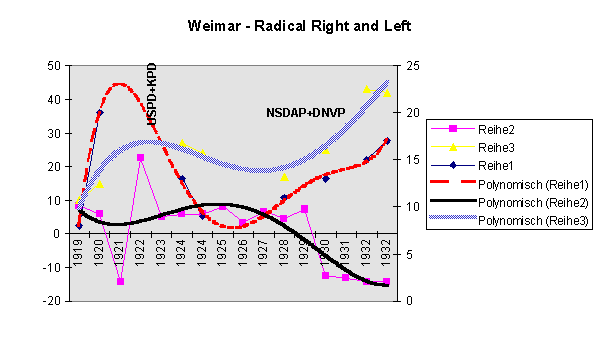
Legend: economic growth on the world level (left hand-scale, dark line); right-wing radicalism in Germany during the Weimar Republic (left-hand scale, shady trend-line) and left radicalism in Germany during the Weimar Republic (right-hand scale, dotted trend-line). Sources: see above
The trend-data from Weimar also show, how, under the impact of a world economic recession, it is the liberal societal center whose voter support most rapidly dwindles, while radicalism increased and the Catholic Center Party approximately could hold its position:
Graph 8.4: Weimar and the end of the liberal center
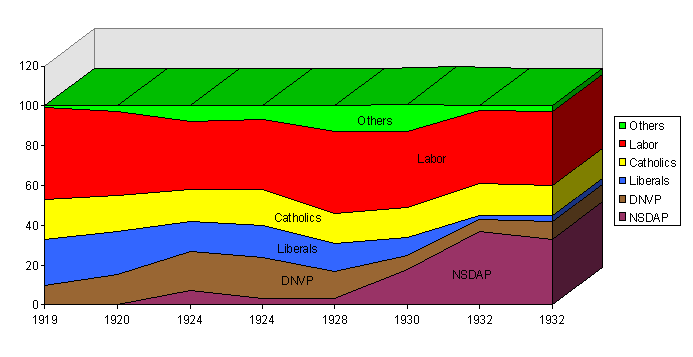
Legend: the share of the different Weimar parties in the total vote from 1919 to 1932. Sources: see above. Catholics and Labor remain practically stable throughout the depression, while the other parties, the liberal and the national right contribute to the rise of the NSDAP.
What, then, is ‘the beef’ of this comparison for today? The resilience of semi-peripheral democracies against world economic shocks has certain limits, and the likelihood of a renewed breakdown of democracy in countries like the Ukraine, Bulgaria, Romania, or Russia cannot be ruled out altogether. This is especially relevant, when we think about the possibly disastrous effects of long-term European stagnation under European Monetary Union on the ‘outs’ in East Central Europe (Friedman, 1997; Watzal, 1997). It is an irony of the day, that the neo-liberal Nobel laureate Milton Friedman compared the EURO project with the gold-standard and thus renewed the warnings of Karl Polanyi, written more than half a Century ago: first declining prices, but after 1896 rising prices, sharp fluctuations. A more thorough analysis of Polanyi’s text (1944) will show the close connection that this author established between democratic instability and monetary orthodoxy in the countries of the European eastern semi-periphery.
For the moment, the world economy seems to prefer the environment of low human development, where political repression is still high enough not to warrant any 'excess repressiveness' of the state security apparatus to control via infringements on the level of civil rights the destabilization, brought about by the lowering of the rate of political repression in heterogeneous countries. Net transfers, that is to say, inflows that are greater than outflows due to international exploitation, in turn determine to a large extent the chances of a country in the semi-periphery and periphery for social development. The empirical relationship is drastic enough to be mentioned here: life expectancy, that single, best, and most reliable indicator of the social situation of a country, is being determined by the well-known e/p-function on the basis of real income in purchasing power, introduced in Tausch/Prager, 1993, and net transfers. Almost 4/5 of life expectancy in the (semi)periphery are thus being determined; net transfers are the predictor of life expectancy, whose unstandardized regression coefficient is 5 times bigger than the standard error of the estimate.
Further support to our interpretations is given by the last two regression equations in Table 4.1. Thus, the countries of the periphery and the semi-periphery today are at the mercy of transnational capital flows: they are at the mercy of transnational capital politically, because inflows of capital stabilize ethno-political conflict potential, and they are the mercy of transnational capital socially, because inflows determine to a large extent and directly the life expectancy of the populations - from Wladiwostock to Hanoi, from Riga to Tirana.
Whether or not democracy in Eastern Europe can survive the transformation shocks, will depend to a large extent also on the kind of world economic relationships that the West is offering to the new democracies. Real transfers out of Weimar Germany, as Frank and Fuentes/Frank have correctly remarked, destabilized German democracy in the pre-war years to a considerable extent. The latest predictions of the Economist Intelligence Unit for the share of the current account balance per real GDP up to the year 2001 show, that in the Czech Republic, Hungary, and Poland, considerable deficits will characterize the transformation process for years to come:
Graph 8.5: current account balances per GDP, 1997 - 2001
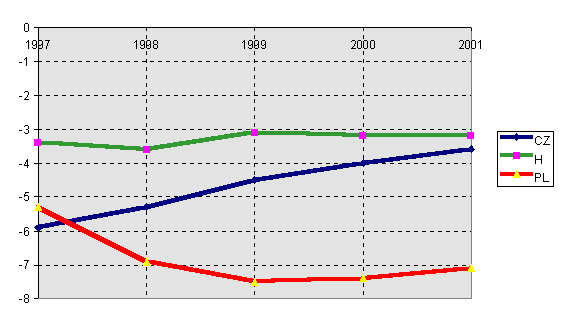
Legend: projections about current account balances per GDP in East Central Europe; based on our own compilations from Business Eastern Europe, February 23, 1998, Dialog Select Information System
On a world scale, democratic transformation of former communism has been combined with long-term growth success practically only in Slovenia and Poland, while the ‘Asian’ authoritarian transformation strategy still seems to offer some tangible benefits in comparison to semi-authoritarian dependent capitalism in most of the former USSR:
Table 8.3: economic growth and political rights violations in (ex)communist nations
|
CZE |
-2,3 |
1 |
|
EST |
-6,1 |
1 |
|
HUN |
-1,3 |
1 |
|
LIT |
-4,5 |
1 |
|
POL |
0,5 |
1 |
|
SLO |
0,6 |
1 |
|
BUL |
-3,7 |
2 |
|
LET |
-7,9 |
2 |
|
MON |
0 |
2 |
|
RUM |
-3,2 |
2 |
|
SLK |
-2,2 |
2 |
|
MOL |
-11,1 |
3 |
|
RUS |
-5,9 |
3 |
|
UKR |
-9,5 |
3 |
|
ALB |
2,1 |
4 |
|
CRO |
2,2 |
4 |
|
GEO |
-17,1 |
4 |
|
KIR |
-5,9 |
4 |
|
MAC |
-7,9 |
4 |
|
ARM |
-13 |
5 |
|
AZE |
-15 |
6 |
|
BLR |
-5,2 |
6 |
|
CAM |
5,2 |
6 |
|
KAZ |
-8,2 |
6 |
|
CHI |
10,1 |
7 |
|
LAO |
6,1 |
7 |
|
TAD |
-11,3 |
7 |
|
TUR |
-6,2 |
7 |
|
UZB |
-1,7 |
7 |
|
VIE |
7,2 |
7 |
Legend: our own compilations from Le Monde (1998), ‘Bilan du Monde, Edition 1998’. Paris: Le Monde, and Stiftung Entwicklung und Frieden (1998).
The relationship between authoritarianism and economic growth in former communism is a fairly constant one, with a significant curve-linear trade-off indicating that stagnation is worst at middle democracy levels:
Graph 8.6: the non-linear trade-off between levels of democracy and economic growth in former communism
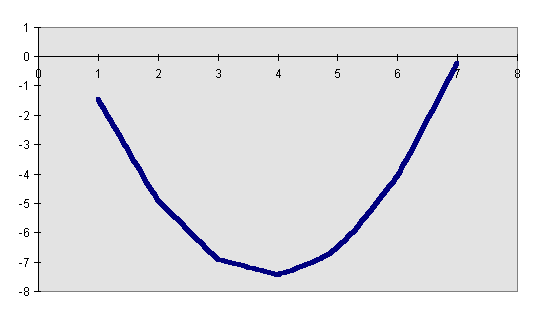
Legend: economic growth (left hand scale) and violations of political rights (x-axis). Economic growth is worst at middle levels of political transformation. The equation is:
(8.2) growth = a + b1* POL RIGHTS VIOL - b2* POL RIGHTS VIOL^2
|
unstandardized c. |
0,733344948 |
-5,659918882 |
3,475900038 |
|
standard error |
0,31115839 |
2,560208118 |
4,181824728 |
|
R^2 |
0,17706894 |
||
|
F/degrees of freedom |
2,904776351 |
27 |
|
|
t-Test |
2,356822028 |
-2,21072609 |
Legend: As in all EXCEL 5.0 outprints in this work, first row: unstandardized regression coefficients, second row: standard errors, last row: t-Test. The values immediately below the standard errors are R^2 (third row, left side entry), F, and degrees of freedom (fourth row).
The stability of the transformation process will also depend, to a large extent, on the ability of the Eastern economies to recover economic growth. In Table 8.4, 8.5 and in Graph 8.7 we show the most recent data about unemployment, growth, and inflation, as well as the discount rate, the budget deficit (surplus) per GDP, debt per GDP, foreign direct investment per GDP, and the current account balance per GDP:
Table 8.4: unemployment, growth, and inflation in the transformation countries
|
Unemployment |
Growth |
Inflation |
|
|
BUL |
13,7 |
-7,4 |
383,1 |
|
CRO |
17,6 |
5 |
5,3 |
|
CZE |
5,6 |
1 |
13,1 |
|
EST |
3,9 |
9 |
14,2 |
|
HUN |
10,4 |
4 |
17,6 |
|
LAT |
6,7 |
6 |
6,4 |
|
LIT |
7,2 |
5 |
6,6 |
|
POL |
10,5 |
7 |
13,7 |
|
ROM |
8,8 |
-6,6 |
132,1 |
|
RUS |
9 |
1,3 |
10,1 |
|
SLK |
12,5 |
6,5 |
7,6 |
|
SLV |
14,5 |
2,9 |
9,1 |
Source: Business Central Europe, April 1998, our own compilations
Graph 8.7: East Central Europe at the hour of boom?
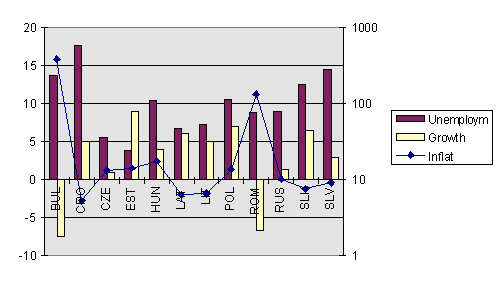
Legend: unemployment and growth (left hand scale); inflation (right hand, logarithmic scale) in East Central Europe. Source: Business Central Europe, April 1998
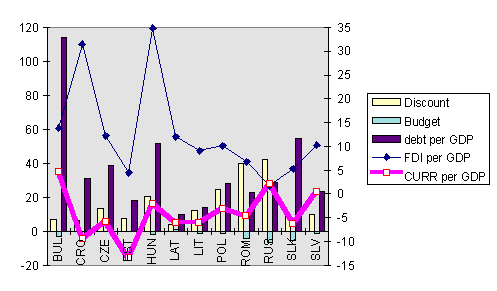
Legend: debt per GDP, discount rate (left hand scale); all other variables (right hand scale); Source: see above
Table 8.5: the discount rate, the budget deficit, debt ratios, investment penetration and current account balance deficits in East Central Europe
|
Discount rate |
Budget deficit |
debt per GDP |
FDI per GDP |
CURR per GDP |
|
|
BUL |
6,8 |
-2,9 |
113,8 |
13,8 |
4,6 |
|
CRO |
5,9 |
-1,6 |
30,9 |
31,4 |
-9,4 |
|
CZE |
13 |
-0,5 |
38,5 |
12,2 |
-5,8 |
|
EST |
7,4 |
-0,1 |
18,2 |
4,5 |
-13,6 |
|
HUN |
20,5 |
-2,1 |
51,6 |
34,8 |
-2 |
|
LAT |
4 |
0,7 |
10 |
12 |
-6 |
|
LIT |
12 |
-1,3 |
14 |
9 |
-6 |
|
POL |
24,5 |
-1,4 |
28,2 |
10,1 |
-3,2 |
|
ROM |
40 |
-4,5 |
22,8 |
6,7 |
-4,7 |
|
RUS |
42 |
-6,8 |
28,9 |
1,7 |
2,1 |
|
SLK |
8,8 |
-5,7 |
54,2 |
5,3 |
-6,3 |
|
SLV |
10 |
-1,5 |
23,1 |
10,2 |
0,5 |
Source: our own compilations from Business Central Europe, April 1998
Poland and the other EU member candidates are confronted with the problem, that their economic performance with 10% unemployment or more, during a world economic cycle peak, is that of a usual center country during a milder recession. Unemployment can soar up again to 15% or more, if the seas of international business cycles become rougher again. Our data series on the basis of Goldstein (see Chapter 3) clearly shows this. In addition, the 7-11 year Polish Juglar business cycle had its last trough in April 1990 (WERI, 1997: 152), and before that in 1980/83, and Poland will certainly enter a Juglar cycle B-phase and then a Juglar cycle trough in the not too distant future. In addition, yet another swing from the 18-22 year Kuznets cycle, that had its last trough internationally by around 1975, might combine with the next local Juglar cycle trough to produce quite a strong recession after the recent boom in Poland:
Graph 8.8: Kuznets-cycles in the world system, 1756 - 1997
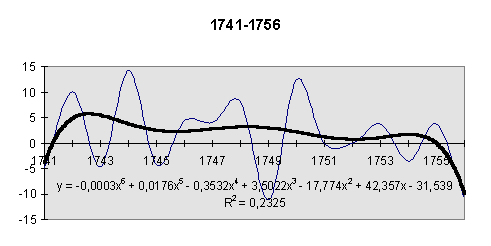
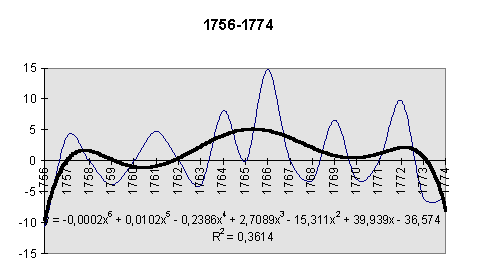
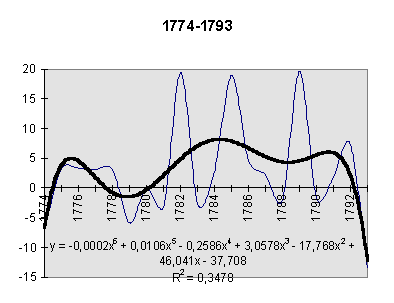
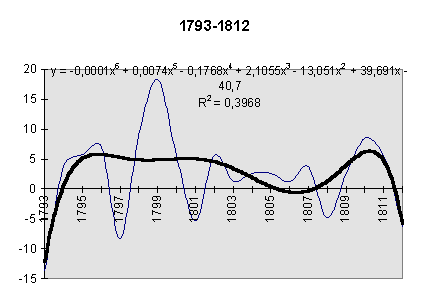
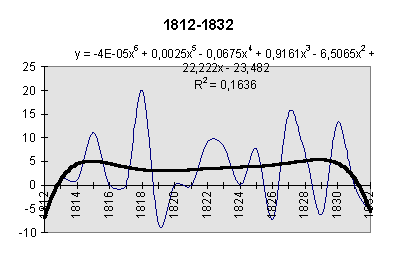
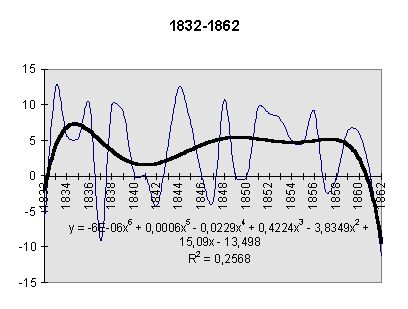
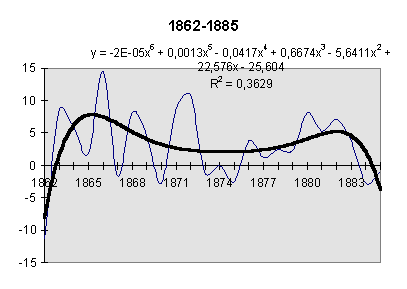
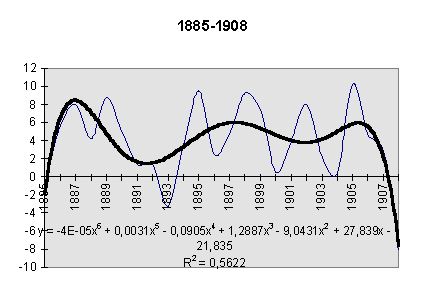
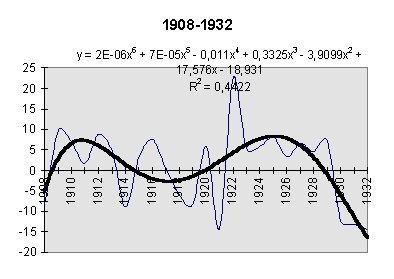
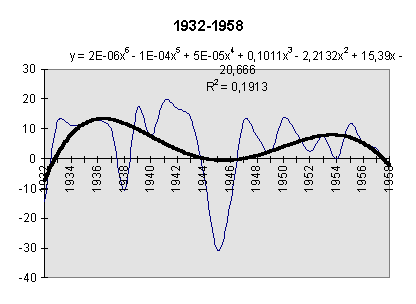
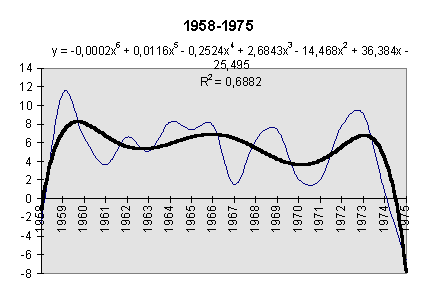
1975 - 1992 (estimate 1)
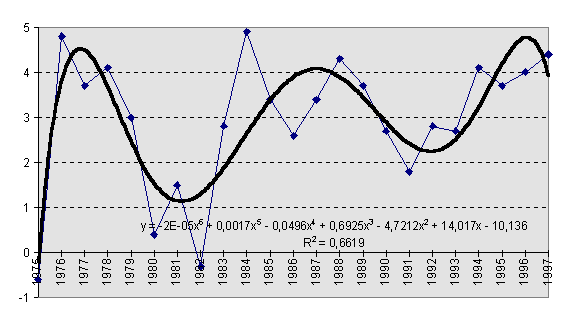
estimate 2
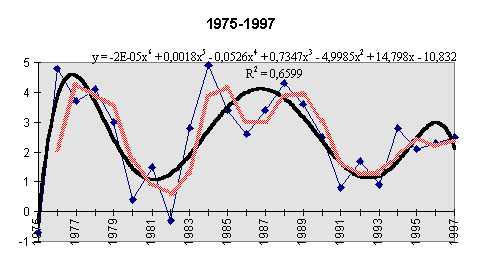
Legend: EXCEL multiple regressions, based on ‘insert trend lines’; the data are the original, un-transformed growth rates of capitalist world production, according to Goldstein, 1988, as calculated in Chapter 3. The data series about industrial country GDP growth 1975 - 1997 is from UN ECE (Economic Survey of Europe), IFRI and IMF sources (World Economic Outlook). In the last graph about growth in the period 1975 - 1998, we also show 2-year sliding averages. The difference between the two data series lies in the assumption about economic growth in the 1990s. (1) is based on IFRI; (2) is based on IMF
The data series about Polish unemployment suggest, that the peak of employment and the trough of unemployment was reached by around November 1997, and that unemployment will increase again during the coming months. Apart from business cycle considerations, also structural factors have to be taken into account, like the restructuring of heavy industry and the demographic dynamics of a baby boom generation, entering the labor market:
Graph 8.9: Polish unemployment 1996 - 1999
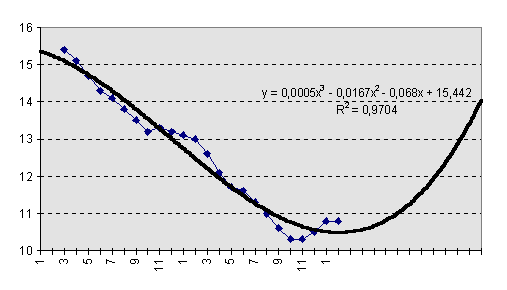
Legend: unemployment in Poland over the last 24 months. Our own calculations, based on G.U.S., 1996-98, Statistical Bulletin, various issues
Formal employment in the economy has quite dramatically shrunk during and after the transformation recession, only to recover very recently:
Graph 8.10: Polish employment in 1000 persons from 1950 to 1996
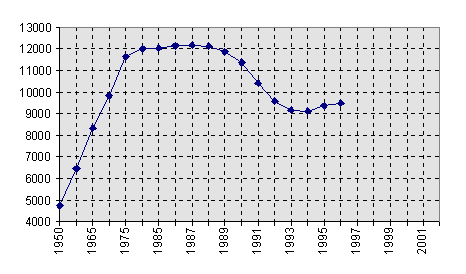
Legend: employment in Poland since 1965. Based on our own compilations from G.U.S., Rocznik Statystyczny Pracy, 1997
We believe, that the EU-accession countries will be confronted in a few years by mounting, and not by declining unemployment rates.
What are the employment policy pre-conditions for the coming years on a European level (see also Chapter 9)?
Europe 1a: Iceland, Norway, Estonia: very low unemployment, as yet no morbus bruxellicus, coastline location
Europe 1b: Russia: still low open unemployment, because the transformation process gets underway only by now. Trade unionism is very weak
Europe 2a: Austria, Switzerland, the Czech Republic, (no or very recent morbus bruxellicus, wage felxibility through strong corporatism still guaranteed), Netherlands: long morbus bruxellicus, but wage flexibilty now guaranteed by very strong liberal elements. Liberal elements will have to increase, the longer morbus bruxellicus lasts
Europe 2b: Britain, Portugal, Lithuania (run-away investment by big transnationals, high wage flexibility achieved by application of neoliberal capitalism; new international division of labor very strongly felt)
Europe 3a: Sweden, Denmark, Ireland: threat of unemployment was very strong in the 1980s, now liberal concepts applied; strong investments in human capital formation and knowledge-based industries
Europe 3b: Latvia, Hungary, Rumania: transformation process underway; countries have already a high potential of urban-rural disparities; with EU-integration, unemployment could rise considerably
Europe 4: Italy, France, united Germany, Slovakia, Poland, Finland: structural transformation from heavy industry to knowledge-based industries not yet completed, historically strong urban-rural inequalities; strong trade-unionism in the cities, high concentration of wealth, low flexibility of wages on the part of the elite of workers who have a secure job; structurally increasing left-right political cleavages. Danger, that high unemployment will increase, if no decisive reforms in the direction of knowledge-based information society are realized. Poland’s and Slovakia’s luck: a long stagnation, followed partially by a shadow-economy-driven growth period. With morbus bruxellicus, the problems will increase.
Europe 5: Spain, Belgium, Slovenia, Croatia, Yugoslavia, Bulgaria: negative weight of old-fashioned industrial structures even larger, combined with the most pressing need to go for knowledge-based industries and better human capital formation. Spain’s case could be less dramatic, with better employment chances for women, especially in the North-western, Central and Southern regions. Belgium, the geographical center of the EU, best symbolizes the morbus bruxellicus
Map 8.4: unemployment in Europe
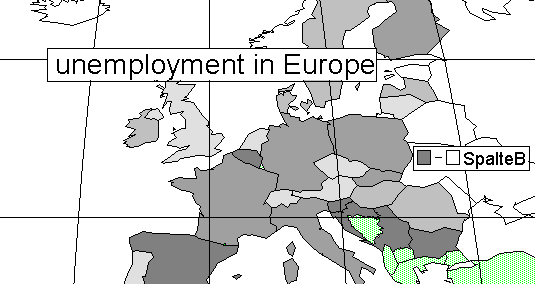
Legend: unemployment rates in Europe. The graph is based on our own compilations from Polish Central Statistical Office, Poland Quarterly Statistics, 3, 1997. The darker, the more severe is the unemployment situation
Semi-peripheral capitalism in Poland also means, that both real wages (as a sign of the political strength of the organized sector’s labor movement) and labor accidents (as a strong sign of the political and social weakness of labor in the unorganized sectors, but also as a sign of the social neglect, that exists in heavy industry during boom years) rise with the ups of the business cycle. The coming Polish recession will strongly increase the pressure of organized labor in the organized, formal sectors in the political system, to proceed with wage demands. Our following statistical materials are based on G.U.S., Rocznik Statystyczny Pracy, and on Business Central Europe:
Graph 8.11: real wage rate and labor accidents in the Polish economy, 1985 - 1996
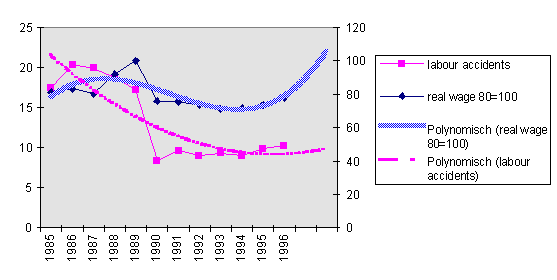
Legend: right-hand scale: real wages (1980 = 100); left-hand scale: deadly labour accidents per 1000 employees and year. Source: our own compilations from Glowny Urzad Statystyczny (1997) ‘Rocznik Statystyczny Pracy’ Warszawa: G.U.S.
Another factor of instability is the glaring deviation of the growth of international currency reserves from the tendencies in the current account balance (see also, Chapter below). In Eastern Europe, Poland and Hungary are the biggest outlayers, suggesting, that gray-sector money flows into these economies. In Poland, this influx is reckoned by Italian police sources to be at the pace of 100000 $ an hour (Polityka, 16, 1998):
Money laundering will however greatly increase for some time to come, especially in Poland, Slovenia and Estonia, where economic conditions are relatively good and EU-membership is just around the corner:
|
currac/GDP |
reserves/GDP |
curr account (per GDP) growth |
reserves (per GDP) growth |
|
|
BULG |
3,8 |
22,1 |
3,8 |
-4,5 |
|
CROA |
-11,9 |
13 |
-7,2 |
-0,1 |
|
CZECH |
-0,6 |
21 |
5,1 |
-5,5 |
|
ESTO |
-2,2 |
17,8 |
0,1 |
-0,4 |
|
HUNG |
-0,9 |
21,6 |
0,4 |
2,6 |
|
LATV |
-9,3 |
13 |
-3,3 |
-1 |
|
LITH |
-11,1 |
12,2 |
-2,2 |
-0,5 |
|
POLA |
-2,1 |
17,8 |
-0,4 |
2,4 |
|
ROMA |
1,1 |
6,9 |
0,3 |
-0,1 |
|
RUSS |
0,4 |
3,5 |
-2,3 |
-0,5 |
|
SLOK |
-7,2 |
16,9 |
-0,3 |
-0,7 |
|
SLOV |
0 |
18,9 |
0 |
1,4 |
Legend: data from Business Central Europe, July, August 1998
Both stocks and flows of current accounts and reserves per GDP each seem to indicate, that Poland indeed is a ‘special case’, where unaccountable inflows dominate the realities of the financial markets:
Graph 8.12: current account balances and international reserves in East Central Europe - without and with outlayers
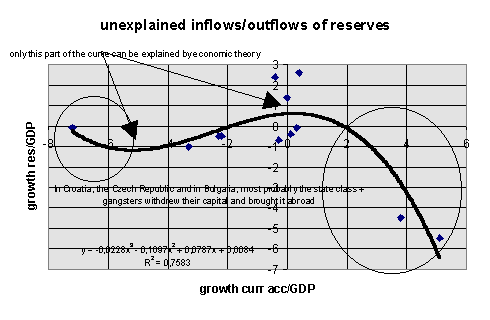
Legend: growth rates of the current account balance per GDP (x-axis) and growth rates of the international reserves per GDP (y-axis); calculated from Business Central Europe, July, August 1998
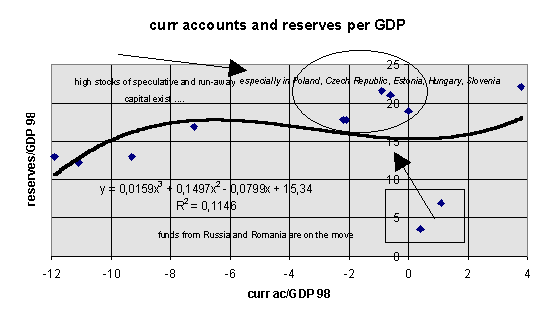
Legend: current account balance per GDP (x-axis) and international reserves per GDP (y-axis); calculated from Business Central Europe, July, August 1998
At the same time, social decay continues - even during boom years, as for example the following data about housing construction from the region suggest:
Table 8.6: housing construction in Eastern Europe and the former USSR
|
Romania |
+ 5% |
|
|
Slovenia |
+ 0% |
|
|
Hungary |
-15% |
|
|
Croatia |
-33% |
|
|
Macedonia |
-40% |
|
|
Turkmenistan |
-42% |
|
|
Russia |
-43% |
|
|
Poland |
-55% |
|
|
Belarus |
-55% |
|
|
other countries |
-55% to -93% |
(Czech Republic -72%; Estonia -82%)
Housing construction: dwellings completed, percentage change 1996 over 1991. Our own compilations from G.U.S., Poland Quarterly Statistics, 3, 1997.
Finally, we should note that by the very same process of radical neo-liberal transformation, the state undermines its own base of existence. If we take general government data for Poland into account, and not just central government data, we find that the following scenario, above described, is the most probable: the share of general government in the GDP sinks, and with it the share of expenditures for police, internal security, and human capital formation, while the general government deficits will grow in the long run. Graph 16 has the details:
Graph 8.13: general government share and deficit in Poland, 1992 - 1997, in percent of GDP
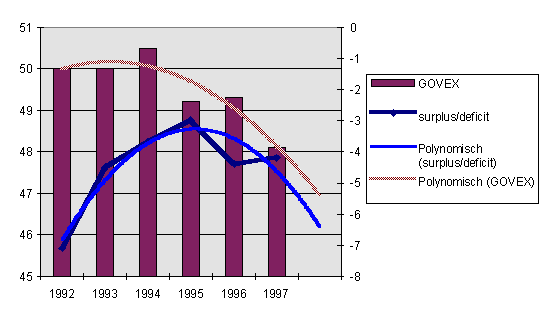
Legend: Polish government expenditures per GDP (columns, left hand scale) and Polish central government surplus/deficits (line, right hand scale) and the trend lines since 1992. Source: our own compilations and estimates from Polish Central Statistical Office, various publications, and from the systematic analysis and evaluation of articles from the Polish Press at Rzczeczpospolita archive (http://www.rzczeczpospolita.pl)
In terms of political stability, a strong state is necessary. This is the lesson of Karl Deutsch’s stability theory. As far as these research results are concerned, they are rather in the tradition of the gloomy description of the conditions of democracy in the semi-periphery in the 1920s, written by Karl Polanyi more than 50 years ago. Will - in contrast to then - the world-wide market economy save Eastern European democracy?
Transnational crime as a global actor
A cynic could say: an economically realistic staging of a G-7 conference would have to invite today the cupolas of transnational crime. In terms of world economic power, international drug traffic alone is more powerful than states like Spain, Russia, or Canada (our own calculations from Raith, 1995, UNDP, 1994). International illegal flight capital prefers certain economic and social conditions; and in turn, it will contribute to changing the socio-economic conditions of its host countries. To investigate the effects of international capital flights on the host countries concerned, we have developed a simple macro-quantitative model. Using standard international economic indicators from Fischer Weltalmanach, we understand money laundering to be the excess international currency reserves, which are unaccounted for by the following data in a multiple regression equation. A surplus means, a country most probably is a heaven for the money launders; while a minus indicates the opposite.
(8.3) money laundering =
|
population |
GNP per capita |
growth 80-93 |
dyn food production |
food imports |
raw material exports |
fertilizer consumption |
curr account |
debt service |
terms of trade |
dyn energy production |
dyn energy consumption |
constant |
|
|
prediction |
687,85 |
1,38 |
-7,018 |
-6,349 |
-0,819 |
1,0837 |
1,7616 |
-12,26 |
1058,8 |
-98,17 |
1,6636 |
10,68 |
-1245 |
|
currency |
335,4 |
107,28 |
56,63 |
37,213 |
0,2119 |
1,0991 |
34,449 |
127,9 |
536,44 |
447,15 |
0,4484 |
4,5276 |
6542,9 |
|
reserves |
0,7034 |
5130,4 |
|||||||||||
|
9,8829 |
50 |
||||||||||||
|
3E+09 |
1E+09 |
||||||||||||
|
t-test |
2,051 |
0,0129 |
-0,124 |
-0,171 |
-3,86 |
0,986 |
0,0511 |
-0,096 |
1,974 |
-0,22 |
3,71 |
2,359 |
Legend: as in all EXCEL 5.0 outprints in this work, first row: unstandardized regression coefficients, second row: standard errors, last row: t-Test. The values immediately below the standard errors are R^2 (third row, left side entry), F, and degrees of freedom (fourth row). Data based on Fischer Weltalmanach, 1997
To assess, in turn, the effect of money laundering on growth, we worked with the following data matrix:
Table 8.7: Money-laundering and its destructive effects on the national economy:
|
population |
GNP per cap |
growth 80-93 |
dyn food prod |
food imp |
raw mat exp |
fertilizer cons |
curr account |
debt service |
terms trade |
money laund |
|
|
Egyp |
56,4 |
660 |
2,8 |
1,3 |
24 |
67 |
3392 |
1566 |
14,9 |
99 |
6873,6 |
|
Algeria |
26,7 |
1780 |
-0,8 |
1,2 |
29 |
97 |
123 |
361 |
76,9 |
95 |
-1638,2 |
|
Argen |
33,8 |
7220 |
-0,5 |
-0,3 |
5 |
68 |
78 |
-7452 |
46 |
116 |
-1256,7 |
|
Ethio |
53,6 |
100 |
-1,8 |
-1,2 |
6 |
96 |
95 |
-183 |
9 |
67 |
-1857 |
|
Bangla |
115,2 |
220 |
2,1 |
-0,1 |
15 |
18 |
1032 |
243 |
13,5 |
94 |
-3065 |
|
Benin |
5,1 |
430 |
-0,4 |
1,9 |
25 |
70 |
82 |
-52 |
5,9 |
133 |
1949,3 |
|
Boliv |
7,1 |
760 |
-0,7 |
0,7 |
9 |
81 |
58 |
-495 |
59,4 |
78 |
-529 |
|
Braz |
156,4 |
2930 |
0,3 |
1,2 |
10 |
40 |
608 |
-637 |
24,4 |
97 |
22358,5 |
|
Burun |
6 |
180 |
0,9 |
-0,3 |
18 |
70 |
34 |
-26 |
36 |
52 |
-2734,3 |
|
Chile |
13,8 |
3170 |
3,6 |
1,9 |
6 |
81 |
849 |
-2093 |
23,4 |
104 |
-524,2 |
|
China |
1178,4 |
490 |
8,2 |
3 |
3 |
19 |
3005 |
-11609 |
11,1 |
101 |
-2670,6 |
|
Costa R |
3,3 |
2150 |
1,1 |
0,7 |
8 |
67 |
2354 |
-470 |
18,1 |
94 |
-6627,4 |
|
Cote Iv |
13,3 |
630 |
-4,6 |
-0,1 |
19 |
83 |
132 |
-1229 |
29,2 |
79 |
-790,3 |
|
Dom Rep |
7,5 |
1230 |
0,7 |
-0,9 |
16 |
47 |
694 |
161 |
12,1 |
130 |
381,3 |
|
Ecuad |
11 |
1200 |
0 |
0,6 |
5 |
92 |
380 |
-360 |
25,7 |
90 |
-1905,8 |
|
El Sal |
5,5 |
1320 |
0,2 |
0,7 |
15 |
52 |
1073 |
-77 |
14,9 |
88 |
-3019,4 |
|
Gabon |
1 |
4960 |
-1,6 |
-1,4 |
17 |
97 |
11 |
-269 |
6 |
106 |
-6344,3 |
|
Ghana |
16,4 |
430 |
0,1 |
0,3 |
10 |
77 |
38 |
-572 |
22,8 |
65 |
-1217,9 |
|
Guatem |
10 |
1100 |
-1,2 |
-0,5 |
11 |
70 |
833 |
-687 |
13,2 |
93 |
-1290,6 |
|
Hondu |
5,3 |
600 |
-0,3 |
-1,3 |
11 |
86 |
210 |
-393 |
31,5 |
73 |
615,7 |
|
India |
898,2 |
300 |
3 |
1,5 |
5 |
29 |
720 |
-315 |
28 |
96 |
-259,2 |
|
Indon |
187,2 |
740 |
4,2 |
2,2 |
7 |
47 |
1147 |
-2016 |
31,8 |
90 |
1351 |
|
Jamaica |
2,4 |
1440 |
-0,3 |
1 |
14 |
34 |
973 |
-182 |
20,1 |
109 |
-3438,7 |
|
Camer |
12,5 |
820 |
-2,2 |
-1,9 |
15 |
86 |
30 |
-638 |
20,3 |
77 |
702,1 |
|
Kenya |
25,3 |
270 |
0,3 |
-0,4 |
8 |
71 |
410 |
153 |
28 |
81 |
-200,5 |
|
Colom |
35,7 |
1400 |
1,5 |
1 |
8 |
60 |
1032 |
-2220 |
29,4 |
68 |
246 |
|
Congo |
2,4 |
950 |
-0,3 |
-1,5 |
19 |
97 |
118 |
-507 |
10,8 |
98 |
437,9 |
|
S-Korea |
44,1 |
7660 |
8,2 |
0,5 |
6 |
7 |
4656 |
384 |
9,2 |
100 |
-693 |
|
Laos |
4,6 |
280 |
2,1 |
-0,2 |
33 |
96 |
42 |
-13 |
9,6 |
90 |
387 |
|
Madag |
13,9 |
220 |
-2,6 |
-1,5 |
11 |
81 |
25 |
-167 |
14,3 |
68 |
1371,7 |
|
Malaw |
10,5 |
200 |
-1,2 |
-4,2 |
8 |
94 |
434 |
-143 |
22,3 |
86 |
4244,7 |
|
Malay |
19 |
3140 |
3,5 |
4,3 |
7 |
35 |
1977 |
-2103 |
7,9 |
99 |
9940,5 |
|
Mali |
10,1 |
270 |
-1 |
-0,9 |
20 |
92 |
103 |
-103 |
4,5 |
102 |
1200,2 |
|
Maroc |
25,9 |
1040 |
1,2 |
2,3 |
17 |
43 |
326 |
-525 |
31,7 |
114 |
-1408,3 |
|
Mauri |
1,1 |
3030 |
5,5 |
0 |
13 |
34 |
2512 |
-92 |
6,4 |
108 |
-6459,2 |
|
Mex |
90 |
3610 |
-0,5 |
-0,9 |
8 |
47 |
653 |
-23393 |
31,5 |
99 |
-601,6 |
|
Nep |
20,8 |
190 |
2 |
1,2 |
9 |
16 |
391 |
-195 |
9 |
97 |
-5203,7 |
|
Nica |
4,1 |
340 |
-5,7 |
-2,7 |
23 |
93 |
246 |
-457 |
29,1 |
94 |
1695 |
|
Niger |
8,6 |
270 |
-4,1 |
-1,8 |
17 |
98 |
4 |
-29 |
31 |
105 |
1819,7 |
|
Nigeria |
105,3 |
300 |
-0,1 |
2,1 |
18 |
98 |
175 |
2268 |
28,9 |
99 |
311,2 |
|
Pak |
122,8 |
430 |
3,1 |
1,2 |
14 |
14 |
1015 |
-3327 |
24,7 |
100 |
-7258,4 |
|
Pan |
2,5 |
2600 |
-0,7 |
-1,2 |
10 |
84 |
476 |
70 |
3,1 |
87 |
-1382,5 |
|
Pap |
4,1 |
1130 |
0,6 |
-0,2 |
17 |
89 |
308 |
495 |
30,2 |
91 |
-967,1 |
|
Para |
4,7 |
1510 |
-0,7 |
1,3 |
11 |
83 |
96 |
-492 |
14,9 |
112 |
-5875,9 |
|
Peru |
22,9 |
1490 |
-2,7 |
-0,4 |
20 |
83 |
216 |
-1768 |
58,7 |
90 |
2438,1 |
|
Philip |
64,8 |
850 |
-0,6 |
-1,3 |
8 |
24 |
540 |
-3289 |
24,9 |
117 |
1732,6 |
|
Poland |
38,3 |
2260 |
0,4 |
0,7 |
11 |
40 |
811 |
-3698 |
9,2 |
95 |
-1086,5 |
|
Port |
9,8 |
9130 |
3,3 |
2,6 |
12 |
17 |
813 |
947 |
19,3 |
104 |
3197 |
|
Roman |
22,8 |
1140 |
-2,4 |
-2,4 |
14 |
24 |
423 |
-1162 |
6,2 |
111 |
4733,1 |
|
Zambia |
8,9 |
380 |
-3,1 |
-0,3 |
8 |
99 |
160 |
-471 |
32,8 |
98 |
2707,6 |
|
Zimb |
10,7 |
520 |
-0,3 |
-3 |
18 |
64 |
481 |
-116 |
31,1 |
89 |
561,3 |
|
Sri Lank |
17,9 |
600 |
2,7 |
-1,8 |
16 |
28 |
964 |
-381 |
10,1 |
86 |
2054,3 |
|
Sudan |
26,6 |
400 |
-0,2 |
-2,2 |
19 |
99 |
72 |
-1446 |
5,4 |
91 |
-931,8 |
|
Tans |
28 |
90 |
0,1 |
-1,3 |
6 |
85 |
137 |
-408 |
20,6 |
85 |
2134,4 |
|
Thai |
58,1 |
2110 |
6,4 |
0 |
5 |
28 |
544 |
-6928 |
18,7 |
103 |
10516 |
|
Trinid |
1,3 |
3830 |
-2,8 |
-0,6 |
15 |
66 |
801 |
122 |
23,8 |
92 |
-6794 |
|
Tunes |
8,7 |
1720 |
1,2 |
1,5 |
8 |
25 |
223 |
-912 |
20,6 |
100 |
-5093,5 |
|
Turk |
59,6 |
2970 |
2,4 |
0,3 |
6 |
29 |
702 |
-6380 |
28,3 |
109 |
-5097,7 |
|
Ugan |
18 |
180 |
1,9 |
0,3 |
8 |
100 |
1 |
-107 |
143,6 |
49 |
-415,7 |
|
Hung |
10,2 |
3350 |
1,2 |
-0,7 |
6 |
32 |
292 |
-4262 |
38,8 |
102 |
825,2 |
|
Urug |
3,1 |
3830 |
-0,1 |
0,3 |
8 |
57 |
608 |
-227 |
27,7 |
114 |
-4631,9 |
|
Venez |
20,9 |
2840 |
-0,7 |
0,2 |
11 |
86 |
874 |
-2223 |
22,8 |
93 |
6139,1 |
|
CAfriR |
3,2 |
400 |
-1,6 |
-1 |
19 |
56 |
5 |
-21 |
4,8 |
91 |
0 |
|
population |
GNP per cap |
growth 80-93 |
dyn food prod |
food imp |
raw mat exp |
fertilizer cons |
curr account |
debt service |
terms trade |
money laund |
This yielded the following results, explaining almost 65% of economic growth:
(8.4) money laundering and economic growth
|
dyn food prod |
food imp |
raw mat exp |
fertilizer cons |
curr account |
debt service |
terms of trade |
money laundering |
lnGNP |
ln GNP^2 |
constant |
|
0,160315 |
-2,43436 |
1,86E-06 |
-0,00958 |
0,004269 |
-4,6E-05 |
0,001343 |
-0,02796 |
-0,02825 |
0,513553 |
11,36795 |
|
0,172427 |
2,366866 |
4,77E-05 |
0,01811 |
0,012305 |
6,88E-05 |
0,000313 |
0,010356 |
0,042082 |
0,164342 |
7,91605 |
|
0,6475 |
||||||||||
|
9,552412 |
52 |
|||||||||
|
0,929751 |
-1,02852 |
0,039072 |
-0,52907 |
0,346949 |
-0,66766 |
4,295231 |
-2,69961 |
-0,67126 |
3,124894 |
t-test |
Legend: as in all EXCEL 5.0 outprints in this work, first row: unstandardized regression coefficients, second row: standard errors, last row: t-Test. The values immediately below the standard errors are R^2 (third row, left side entry), F, and degrees of freedom (fourth row).
The Matthew’s effect, terms of trade, and money laundering explain significantly economic growth in the world periphery and semi-periphery from the 1980 onwards. 64.8% of total variance is accounted for by our model. Contrary to the myth, that - however morally detestable, such a shadow economy is beneficial for economic growth-, the opposite holds.
Another way to look at the problem would be via the international corruption index, ranging from 0 (high corruption) to 10 (low corruption), that is now calculated for 52 countries (Polityka, Warsaw, 32, 1998: 35). First of all, corruption is a typical inverted U-shaped function of overall development level, namely:
Graph 8.14: corruption as a function of overall development - the Human Development Index and the absence of Corruption Index
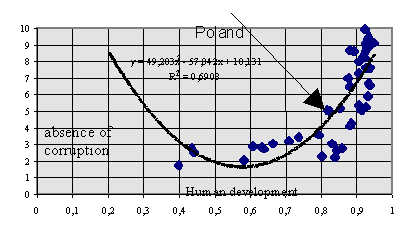
Legend: Human Development Index (x-axis, ranging from 0 to 1) and the absence corruption, as measured by the Transparency International survey (y-axis, ranging from 0 (absolute corruption) to 10 (absolute rule of law)). The Graph shows that Poland’s and Hungary’s performance are a normal consequence of their still relatively low level of human development, but that they already have ‘the worst behind them’, while countries in Latin America and in the European Union, like Italy, Belgium, Greece, leave much to be desired in their performance, and still have an excessive level of corruption, as compared to their development level. Source: our own compilations from the data base of Chapter 9 of this work and from Polityka, 32, 1998: 34 - 35.
The above hypothesis about the inverted U-shaped pattern of the increase/decrease in corruption levels can be further specified. Endemic corruption, it seems, is the consequence of a number of factors of the development and decay process in the world system, among others the upward push, that corruption receives from excessive military outlays and high population growth. The U-shaped pattern of corruption is again shown to be relevant here, while foreign capital penetration has no significant effect on corruption patterns:
(8.5) factors affecting corruption
|
UN memb.y |
mean y scho |
absoluteGNP |
FDI per GDP |
Years of Comm |
population gr |
state sector |
%labor force |
ln PPP |
ln PPP^2 |
||
|
1,5787 |
0,0243 |
-0,0255 |
0,7965 |
-13,311 |
0,099 |
0,0375 |
0,2197 |
-0,035 |
0,045 |
||
|
corruption |
6,6604 |
0,1057 |
0,0551 |
0,6243 |
11,867 |
0,0397 |
0,0248 |
0,3411 |
0,0182 |
0,0174 |
|
|
0,853 |
|||||||||||
|
14,753 |
33 |
||||||||||
|
t-Test |
0,237 |
0,2303 |
-0,4627 |
1,2759 |
-1,1217 |
2,489 |
1,5117 |
0,6441 |
-1,907 |
2,613 |
|
|
agr.shareGP |
MILEX |
HDI |
constant |
|
-0,0003 |
0,263 |
0,0046 |
50,698 |
|
0,0002 |
0,1285 |
0,0154 |
52,183 |
|
-1,2912 |
2,047 |
0,3014 |
0,9715 |
Legend: as in all EXCEL 5.0 outprints in this work, first row: unstandardized regression coefficients, second row: standard errors, last row: t-Test. The values immediately below the standard errors are R^2 (third row, left side entry), F, and degrees of freedom (fourth row).
Thus, it seems to be certain that corruption levels in Poland and other transformation countries will decrease, while arms imports, connected with NATO-membership, will push corruption levels upwards for some time to come.